Sapphire
All non-red varieties of the mineral corundum.
Sapphire shop
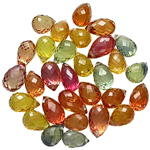
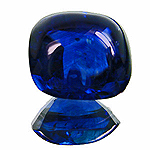
A lot of multicoloured sapphires and a blue sapphire bufftop.
The orange colours are caused by beryllium treatment.
The stand-alone term sapphire always means the blue variety. All other colours must be mentioned. Thus one speaks of yellow sapphire, purple sapphire, padparaja sapphire etc.
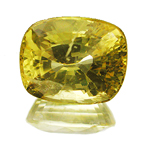
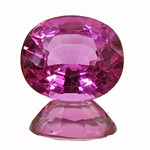
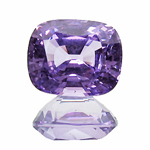
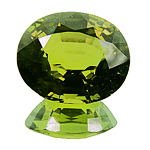
Origin of name: from greek σάπφειρος, sappheiros, which derives from Hebrew ספיר, cappiyr. These words denote blue gem stones like sapphire, lapis lazuli and possibly some others.
Synonyms and trade names: none. There are, however, a number of trade names containing the word "sapphire". We strongly condemn this practice, the sole purpose of which is to ennoble cheaper gems and entice potential customers to buy, sometimes for too high a price.
The terms lux sapphire (or luxsapphire) and water sapphire for iolite were relatively common some decades ago. Occassionally one encounters sapphire spinel for blue spinel or sapphire quartz for blue chalcedony.
Blue Tourmalines were sometimes labelled Brazilian sapphires, Uralian sapphire or some such nonsens.
Can be confused with: other blue gems, synthetics and glass.
Blue sapphire might be confused with tanzanite or iolite. Some rare collector´s gems like benitoite, cyanite or haüyin come in sapphire-like blues. However, being what they are – rare collector´s gems – they are hard to come by on the market. In any case diagnosis usually is quite simple, considering their very different optical properties.
Identification of synthetic sapphires
The synthetic sapphires encountered most frequently in the trade are so-called Verneuil sapphires
Other synthetics, which are produced by more sophisticated and expensive methods, can pose serious problems, though. Careful microscopic studies of inclusions mostly lead to successful identification, where loupe and experience do not suffice. In very rare cases advanced technology like element analysis by e.g. x-ray diffraction or Raman-Spectroscopy has to step in.
The good news: the danger to fall for a high-end synthetic sapphire (or ruby) has diminished significantly over the last years. Due to enormous production costs and probably also due to unsatisfying economic success, several companies have stopped production or closed down altogether.
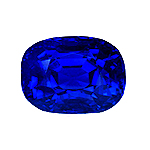
Typical Kashmir colour
The exact date of the discovery is controversial. Sometime between 1882 and 1897 the first gems were probably unearthed by a landslide. Some years later a second, much less productive deposit was found about 250 meters downhill.
The area is inaccessable, to say the least, and can only be reached by helicopter or on foot with the nearest road being 6-8 days of strenuous walking away. On top of this it is covered in snow for nine to ten months of the year.
The two mines were worked intermittently until 1927. The so-called Old Mine was depleted and closed after six years only. However, the gems mined in this short period were of outstanding quality. Kashmir sapphires became an instant legend and until today set the standards for all blue sapphires.
What makes Kashmir sapphires so desirable is their fine royal blue combined with an unrivalled velvety appearance.The latter is due to a very slight milkyness caused by needle-shaped rutile inclusions.
Second in fame is Mogok in Burma. Mostly known for rubies, Mogok also produces some of the world´s fines sapphires. Burma sapphires show intense blue colour and very little colour zoning.
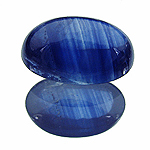
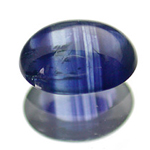
Color zoning (in Thai sapphires)
This lack of zoning distinguishes them from the Sapphire deposits next in the ranking, Ceylon.
The gem riches of Sri Lanka are legendary. In fact, the island has so many gem deposits, one can rightly assume that the first gems were discovered only a short time after it was populated from India. At any rate there is proof that Sri Lanka´s ruby and sapphire trade is as old as 2000 years.
On average Ceylon sapphires, as they are still called in the trade, are of lighter tone than Sapphires form other sources. They are characterized by a multitude of "fingerprint inclusions", mineral inclusions and distinct colour zoning. Viewing from the side they quite often show a colour concentration in the tip (the culet) with the rest of the stone being colourless.
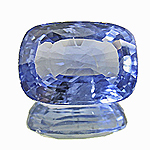
Typical Ceylon colour, untreated
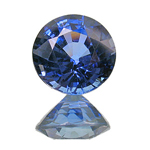
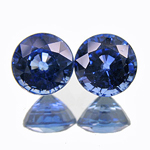
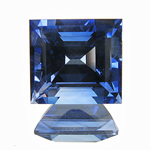
Heat-treated Ceylon sapphires of very fine quality
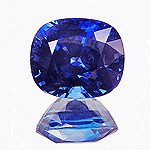
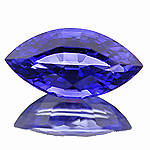
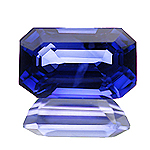
Some of our best sapphires are from Sri Lanka
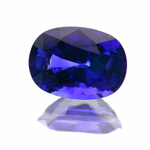
Sapphire from Ilakaka, Madagaskar
The fact that Madagascar sapphire is hardly found in the trade and that traders from Sri Lanka are the second largest group of buyers of sapphire rough in Ilakaka is a strong indication that most Madagascar sapphire enters the world trade as Ceylon sapphire. Besides there is hardly any gem cutting going on in Madagascar. Most of the rough is being cut in Thailand and in Sri Lanka.
Until the beginning of the 1990ies Thailand was an important source of blue sapphire, as well. Deposits in the vicinity of the town of Kanchanaburi supplied huge quantities of mostly rather cheap quality. Truly fine stones were few and far between. Most Kanchanaburi sapphires were slightly hazy. The haziness was due to clouds of rutile dust, dissolved from rutile needles during heat treatment.
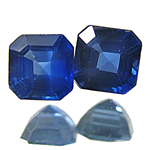
Kanchanaburi sapphire
Another, obviously now depleted source was Pailin in Cambodia. Sapphires were mined until the mid 1990ies. Sapphires of sizes up to about 0.50cts were of really beautiful, intense colour. Larger stones tended to be too dark in tone.
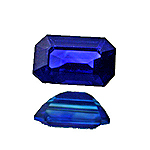
Fine Pailin sapphire
Last but not least Australia must be mentioned as a source of sapphire. The continent down under produces rather large quantities of, alas, rather questinable colour. Many Aussie sapphires are treated in Thailand but despite all efforts – Thais are the unsdisputed champions of gemstone enhancement – most stones are too dark for the international markets and quite often sport an undesirable greenish tinge.
Cut
Quality of cut is very important with sapphire. Other than with ruby, a flat, weightsaving cut is considered a severe flaw.
Ceylon sapphires (cut in the country of origin), in particular, are often cut to maximize weight (and profit for the owner of the rough) and sport a very bulgy pavilion, indeed. Now, contrary to a shallow pavilion, a fat, bulgy pavilion does not have such a devastating effect on brilliance, but it does mean excess weight and thus excess money. Furthermore it impedes setting and makes it more expensive.
Sometimes the problem can be solved by re-cutting but beware, Lankans have long mastered the art of cutting sapphires in such a way that they appear uniformly coloured when viewed through the table. In fact the colour might be concentrated in the culet. So if you recut the pavilion you will grind off all colour!
Which takes us to the second quality criterion
Colour
What pigeonbllod red is for ruby, cornflower blue is for sapphire. What both terms have in common is that they are associated with different shades by different people.
As a rule the colour of blue sapphire, as that of any other stone, should be pure. Any greenish tinge, like in many Aussie sapphires, is unwanted. Sometimes blue sapphires have a distinct purplish tinge, which is also seen as a blemish.
As far as colour intensity is concerned, the public´s taste has shifted markedly in the last twenty years, or so. What was considered ideal colour in the 1980ies is too dark for most people´s taste today. What was considerd "darkish" then, like most Australian, some Thai and many Pailin (Cambodian) sapphire, is unquestionably much too dark and virtually unsellabe today.
Carat (size)
Size, of course, does influence price per carat, albeit not nearly as dramatically as with ruby.
A 5cts sapphire will fetch a higher price per carat than a 3cts stone of comparable quality but that difference will not (yet?) be several tens of thousands of dollars.
Clarity
The last "C" also is of rather high importance, higher than with rubies. As long as a ruby has good colour, buyers can be found, even if it has so many inclusions that the term "transparency" is no longer appropriate.
With sapphires the standards applied are rather strict. Any decrease of brilliance gets punished during appraisal and truly dull, no-see-through sapphires are almost impossible to sell.
Thermal Treatment
Sapphires mostly are heated to intensify their colour. This is different from ruby treatment, where the main goal is to remove undesirable bluish or brownish tinges.
The most important chromophore (colouring agent) of blue sapphire is titanium. One of the most common inclusions in sapphire is rutile, a titanium mineral. Upon heating titanium ions diffuse from the rutile inclusion into the surrounding sapphire host and produce or intensify the blue colour.
To a certain extent it is possible to reduce the greenish tinge of some Australian sapphires or to light their tone but, in our opinion, Aussie sapphire is Aussie sapphire…
Handling: due to the great hardness and the absence of cleavage sapphire generally is easy to work with. However, sapphires can be heat-sensitive. High temperatures can cause a colour change.
Most corundums have mineral and liquid inclusions. These have higher expansion coefficients than their host. Thus they expand more upon heating which can produce cracks or even total destruction.
Sensitive to salts and brines. No borax!
Worth knowing: particularly in Sri Lanka and Tanzania sapphires with a colour change from blue in daylight to purple in incandescent light can be found. As recent as twenty years ago this was considered a serious flaw. Today colour changing sapphires are a rarity sought after by connoisseurs.
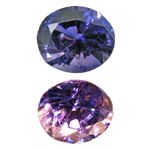
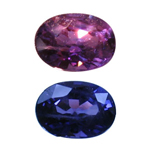
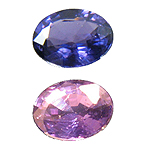
Asterism (star effect) is not uncommon in sapphires
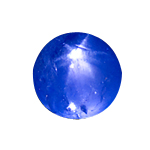
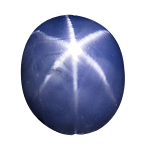
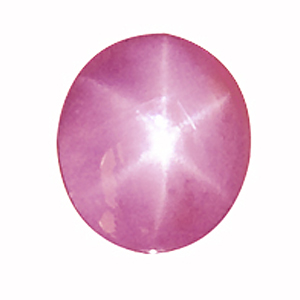
3 fine Star sapphires from Sri Lanka
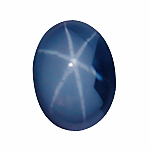
Star sapphire from Madagaskar
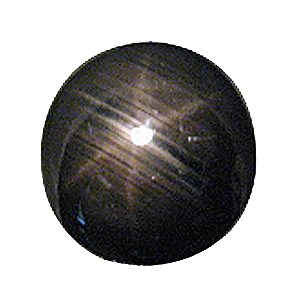
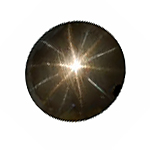
Particularly in black star sapphires from Thailand one occasionally finds 12-rayed specimens
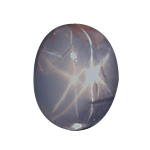
Unusual specimen with a double star, Sri Lanka
Sapphire shop
 Deutsch
Deutsch